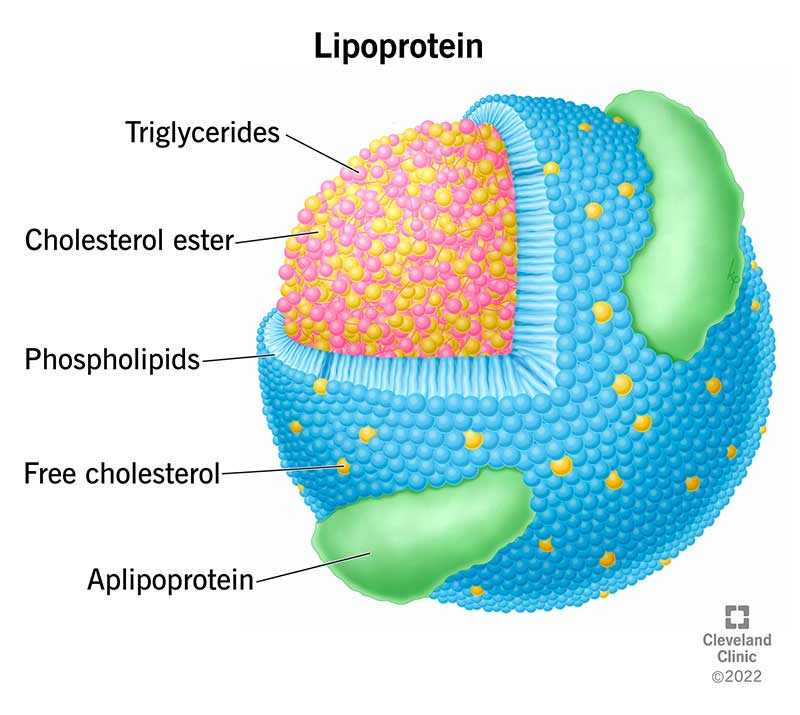Lipoproteins carry cholesterol and triglycerides to cells in your body. HDL (good cholesterol) gets rid of LDL, the bad cholesterol that clogs arteries. A gene causes high levels of lipoprotein (a), or LP(a), which narrows arteries. A lipid blood test measures lipoprotein levels. Lifestyle changes and medicines like statins treat high cholesterol.
Advertisement
Cleveland Clinic is a non-profit academic medical center. Advertising on our site helps support our mission. We do not endorse non-Cleveland Clinic products or services. Policy
Lipoproteins are round particles made of fat (lipids) and proteins that travel in your bloodstream to cells throughout your body. Cholesterol and triglycerides are two types of lipids found in lipoproteins.
Advertisement
Cleveland Clinic is a non-profit academic medical center. Advertising on our site helps support our mission. We do not endorse non-Cleveland Clinic products or services. Policy
Your body makes different types of lipoproteins. High levels of certain lipoproteins can be harmful to your heart. But some lipoproteins have heart-protective benefits.

Cholesterol and triglycerides are waxy fats that circulate in your blood. Your body produces and uses these fats differently:
There are five main types of lipoproteins:
Advertisement
Lipoprotein (a) or LP(a) is a type of LDL (“bad cholesterol”). A second protein called apolipoprotein or apo(a) loops around it in segments called kringles. Apolipoprotein makes the LDL particles stickier. As a result, LP(a) builds up in blood vessels, increasing the risk of cardiovascular problems. High levels of LP(a) are a risk factor for atherosclerosis.
While diet and certain lifestyle choices can affect HDL and LDL levels, your genes determine your LP(a) levels. Some people inherit gene changes (mutations) that make them more prone to high LP(a) levels. These people have a higher risk of heart disease at a young age.
Healthcare providers order lipid blood tests to measure total cholesterol in your blood. The tests provide individual results for HDLs, LDLs and triglycerides and total cholesterol.
Any cholesterol test is a simple blood draw that takes fewer than five minutes. You may get the test at your healthcare provider’s office, blood testing lab or hospital. For the most accurate results, you need to fast for eight to 12 hours before getting this blood test. You may also need to stop taking certain medicines before the test. You should follow your healthcare provider’s directions.
It isn’t standard practice to test LP(a) levels. You’ll only have testing for LP(a) levels during a lipid blood test if your healthcare provider specifically requests it.
Providers typically order the test only for those who have known heart disease risk factors like:
High cholesterol rarely causes symptoms. Testing is the best way to identify cholesterol issues that affect your heart and blood vessels.
Healthcare providers use lipid blood tests for:
Advertisement
High lipoprotein and total cholesterol levels become more of a problem with age. As the risk rises, your healthcare provider may order more frequent tests.
Recommendations for lipid blood tests include:
Labs measure cholesterol and lipoproteins in milligrams per deciliter (mg/dL). Individual laboratories can use different techniques. That means results from the same blood sample can vary from lab to lab. When possible, your provider will want to use the same lab to monitor your levels.
Healthy ranges for HDLs, LDLs, triglycerides and total cholesterol vary by age and sex. Talk with your healthcare provider about what levels are healthy for you. In general, these numbers are in the healthy range if you have no other risk factors:
Advertisement
A lipid blood test can’t measure VLDL levels, and there isn’t a separate test. Instead, labs estimate VLDL levels by dividing your triglyceride numbers by five. A healthy VLDL level would be less than 30 mg/dL. But this equation isn’t always accurate when triglyceride levels are too high.
Labs report LP(a) levels in mg/dL or nanomoles per liter (nmol/L). A reading above 50 mg/dL or 75 nmol/L is high and increases your risk for atherosclerosis, heart attacks and strokes.
People who have gone through menopause and adults over 40 are most at risk for high LDL levels. But even children can have cholesterol problems. As you get older, your metabolism slows and your liver doesn’t remove bad cholesterol from your body as well.
Race and ethnicity also play a role. Asian Americans are more prone to high LDL levels, while white people are more likely to have high total cholesterol.
Additional risk factors for high LDL levels include:
Advertisement
People at high risk for heart attacks, stroke and other issues due to high LDL levels often need cholesterol-lowering drugs like statins, ezetimibe, and PCSK9 inhibitors. You can also make dietary and lifestyle changes to improve your numbers.
Dietary and lifestyle changes can lower bad cholesterol (LDLs) and boost good cholesterol (HDLs). These steps can help:
There are different types of lipoproteins. HDL is a “good cholesterol” that helps your body get rid of LDL, the “bad cholesterol” that clogs arteries. Your behaviors, including diet, smoking and exercise, affect lipoprotein levels. Some people inherit a gene change that causes high levels of lipoprotein (a) or LP(a). This “sticky” lipoprotein builds up in arteries, increasing your risk of heart disease. Lifestyle changes and medications like statins can lower LDL and LP(a) levels while boosting HDL.
Cleveland Clinic’s primary care providers offer lifelong medical care. From sinus infections and high blood pressure to preventive screening, we’re here for you.

Last reviewed on 05/22/2022.
Learn more about the Health Library and our editorial process.